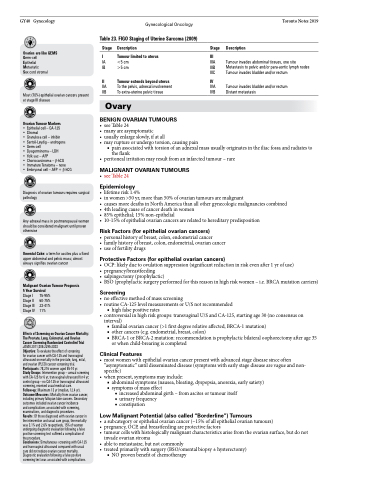Page 526 - TNFlipTest
P. 526
GY40 Gynecology
Gynecological Oncology
Toronto Notes 2019
Ovaries are like GEMS Germ-cell
Epithelial
Metastatic
Sex cord stromal
Most (70%) epithelial ovarian cancers present at stage III disease
Table 23. FIGO Staging of Uterine Sarcoma (2009)
Stage Description
I Tumour limited to uterus
IA <5 cm IB >5 cm
II Tumour extends beyond uterus
IIA To the pelvis, adnexal involvement IIB To extra-uterine pelvic tissue
Ovary
BENIGN OVARIAN TUMOURS
• seeTable24
• manyareasymptomatic
• usually enlarge slowly, if at all
• may rupture or undergo torsion, causing pain
Stage Description
III
IIIA Tumour invades abdominal tissues, one site
IIIB Metastasis to pelvic and/or para-aortic lymph nodes IIIC Tumour invades bladder and/or rectum
IV
IVA Tumour invades bladder and/or rectum IVB Distant metastasis
Ovarian Tumour Markers
• Epithelial cell – CA-125
• Stromal
• Granulosa cell – inhibin
• Sertoli-Leydig – androgens • Germcell
• Dysgerminoma – LDH
• Yolk sac – AFP
• Choriocarcinoma – β-hCG
• Immature Teratoma – none
• Embryonal cell – AFP + β-hCG
Diagnosis of ovarian tumours requires surgical pathology
Any adnexal mass in postmenopausal women should be considered malignant until proven otherwise
Omental Cake: a term for ascites plus a fixed upper abdominal and pelvic mass; almost always signifies ovarian cancer
Malignant Ovarian Tumour Prognosis 5 Year Survival
■ pain associated with torsion of an adnexal mass usually originates in the iliac fossa and radiates to the flank
• peritonealirritationmayresultfromaninfarctedtumour–rare
MALIGNANT OVARIAN TUMOURS
• seeTable24
Epidemiology
• lifetime risk 1.4%
• in women >50 yr, more than 50% of ovarian tumours are malignant
• causesmoredeathsinNorthAmericathanallothergynecologicmalignanciescombined • 4thleadingcauseofcancerdeathinwomen
• 85%epithelial;15%non-epithelial
• 10-15% of epithelial ovarian cancers are related to hereditary predisposition
Risk Factors (for epithelial ovarian cancers)
• personalhistoryofbreast,colon,endometrialcancer
• familyhistoryofbreast,colon,endometrial,ovariancancer • useoffertilitydrugs
Protective Factors (for epithelial ovarian cancers)
• OCP:likelyduetoovulationsuppression(significantreductioninriskevenafter1yrofuse)
• pregnancy/breastfeeding
• salpingectomy(prophylactic)
• BSO(prophylacticsurgeryperformedforthisreasoninhighriskwomen–i.e.BRCAmutationcarriers)
Screening
• noeffectivemethodofmassscreening
• routineCA-125levelmeasurementsorU/Snotrecommended
■ high false positive rates
• controversialinhighriskgroups:transvaginalU/SandCA-125,startingage30(noconsensuson
interval)
■ familial ovarian cancer (>1 first degree relative affected, BRCA-1 mutation)
■ other cancers (e.g. endometrial, breast, colon)
■ BRCA-1 or BRCA-2 mutation: recommendation is prophylactic bilateral oophorectomy after age 35
or when child-brearing is completed
Clinical Features
• most women with epithelial ovarian cancer present with advanced stage disease since often “asymptomatic” until disseminated disease (symptoms with early stage disease are vague and non- specific)
• when present, symptoms may include:
■ abdominal symptoms (nausea, bloating, dyspepsia, anorexia, early satiety) ■ symptoms of mass effect
◆ increased abdominal girth – from ascites or tumour itself ◆ urinary frequency
◆ constipation
Low Malignant Potential (also called “Borderline”) Tumours
• asubcategoryorepithelialovariancancer(~15%ofallepithelialovariantumours)
• pregnancy,OCP,andbreastfeedingareprotectivefactors
• tumourcellswithhistologicallymalignantcharacteristicsarisefromtheovariansurface,butdonot
invade ovarian stroma
• abletometastasize,butnotcommonly
• treatedprimarilywithsurgery(BSO/omentalbiopsy±hysterectomy)
■ NO proven benefit of chemotherapy
Stage I Stage II Stage III Stage IV
75-95% 60-75% 23-41% 11%
Effects of Screening on Ovarian Cancer Mortality: The Prostate, Lung, Colorectal, and Ovarian Cancer Screening Randomized Controlled Trial JAMA 2011;305:2295-2303
Objective: To evaluate the effect of screening
for ovarian cancer with CA-125 and transvaginal ultrasound on mortality in the prostate, lung, ectal, and ovarian (PLCO) cancer screening trial. Participants: 78,216 women aged 55-74 yr.
Study Groups: Intervention group – annual screening with CA-125 for 6 yr, transvaginal ultrasound for 4 yr; control group – no CA-125 or transvaginal ultrasound screening, received usual medical care.
Follow-up: Maximum 13 yr (median, 12.4 yr). Outcome Measures: Mortality from ovarian cancer, including primary fallopian tube cancers. Secondary outcomes included ovarian cancer incidence
and complications associated with screening, examinations, and diagnostic procedures.
Results: Of those diagnosed with ovarian cancer in the intervention and usual care group, the mortality was 3.1% and 2.6% respectively. 15% of women undergoing diagnostic evaluation following a false positive screening test suffered a complication of the procedure.
Conclusions: Simultaneous screening with CA-125 and transvaginal ultrasound compared with usual care did not reduce ovarian cancer mortality. Diagnostic evaluation following a false positive screening test was associated with complications.


